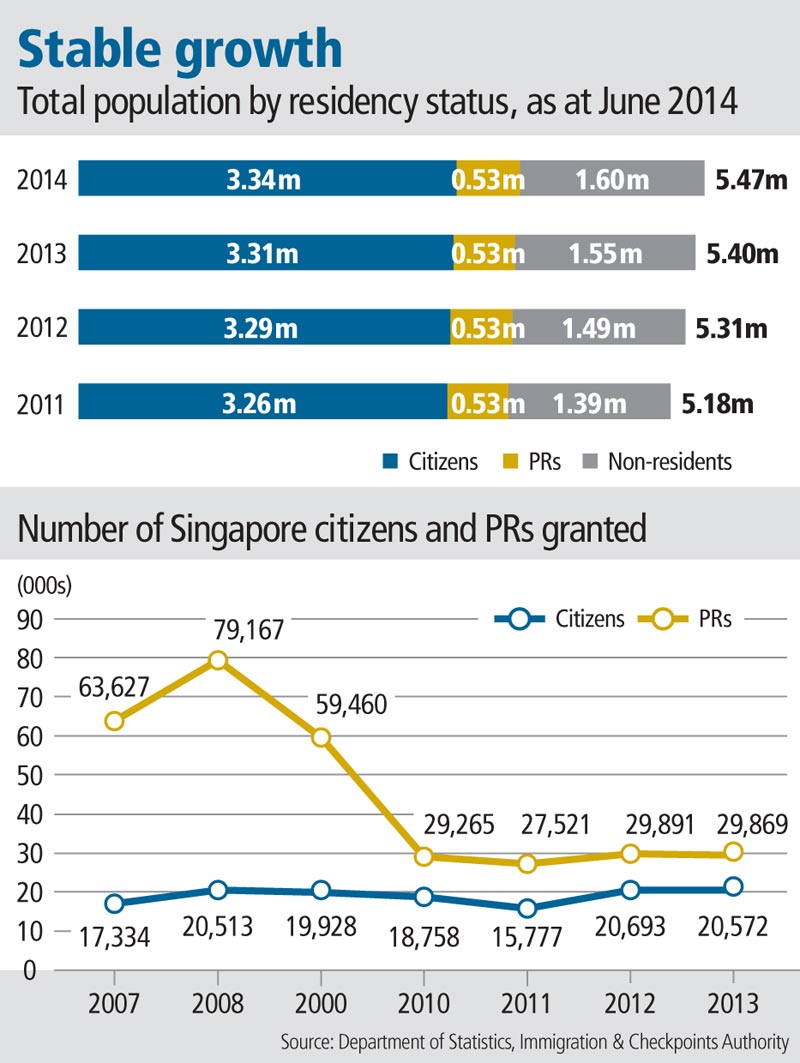Population grows to 5.47m, at slowest pace in 10 years

[SINGAPORE] The Republic's population growth has slid to its lowest in a decade, fertility rates have fallen further, and ageing continues at a rapid pace.
While these may have negative repercussions on the economy, some economists say the situation may not be as dire as generally predicted, since more older citizens are opting to work past retirement age.
Latest government figures released by the National Population and Talent Division (NPTD) on Thursday show that the total population grew at its slowest pace in 10 years, expanding just 1.3 per cent to 5.47 million as of June this year.
The easing in total population growth was driven by slower expansion in the non-resident population, which now stands at 1.6 million - an increase of 2.9 per cent compared to 4 per cent a year ago. This was, in turn, a result of the government's tight restrictions on foreign labour inflows, which saw foreign employment growth slow to 3 per cent versus 5.9 per cent the previous year.
By granting 20,000 new citizens and 30,000 new permanent residents (PRs) annually in the past few years, the government has kept immigration numbers stable. This is even as the citizen population continues to age, and as Singaporeans have fewer than enough babies to replace themselves. With increasing life expectancy and low fertility rates, there are more citizens in the older age groups today. The proportion of citizens aged 65 years and above rose to 12.4 per cent in 2014 from 11.7 per cent a year ago, while the median age of Singaporeans increased to 40.4 years from 40 years previously. This means the old-age support ratio - which is the number of citizens in the working age band of 20 to 64 needed to support one older citizen - is shrinking rapidly.
It fell from 11.4 in 1980 to 8.4 in 2000, before sinking further to 5.2 in 2014. At the same time, the resident total fertility rate (TFR) fell to 1.19 in 2013 from 1.29 in 2012, which was a "dragon year" on the Chinese zodiac. While NPTD said that the dip from 2012 to 2013 was gentler compared to previous post-dragon years, the overall TFR of 1.19 is far below the replacement level of 2.1.
Taken on their own, the latest population statistics paint a rather grey picture of Singapore's future. A shrivelling old-age support ratio would mean greater pressure on the working population and more stress on fiscal policy - worrying trends which population experts have long flagged.
But some economists told The Business Times that not all is doom and gloom.
Said UOB economist Francis Tan: "The support ratio worsening is just one side of things. Other factors are also at play here: the government is incentivising older workers to stay employed; people are questioning whether their retirement savings are enough so they're continuing to work; the government's foreign worker quotas are forcing companies to provide higher wages and that has enticed more elderly people at the margins to join the job market.
"Taken together, these conditions should make us less worried about this scary 5.2 old-age support ratio. I'm not saying the downward trend is not a concern, but I think we can't look at population numbers purely on their own - we need to look at labour market trends too." Indeed, according to figures from the Ministry of Manpower (MOM), the total labour force participation rate of residents aged 65-69 have increased dramatically from a decade ago. While this stood at 19.5 per cent in 2003, it climbed to 27.5 per cent five years later in 2008, before spiking up to 40.2 per cent in 2013.
And amid the tight labour market, MOM said in January this year that the labour force participation rate rose to a new high in 2013, driven by women and older residents.
Noted OCBC economist Selena Ling: "If the retirement age changes to 67, that will skew the ratio for sure as more elderly (persons) rejoin the workforce.
Then the reality may not be as bad as what the (population) numbers suggest."
Still, Mr Tan, Ms Ling, and other economists are concerned about the nation's lacklustre fertility rate and swiftly ageing population.
Said DBS economist Irvin Seah: "This demographic shift is perhaps the biggest challenge facing Singapore...
The situation isn't easy to reverse, and it will take more than conventional economic policy to resolve.
Mindsets will have to change."
kellytay@sph.com.sg
@KellyTayBT


Get The Business Times for more stories.